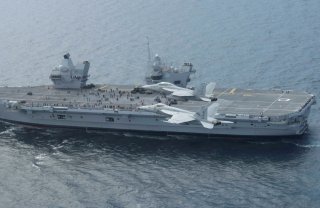The HMS Queen Elizabeth’s F-35B Fighter Jets are Ready for Combat Strike Operations
The Royal Navy will transform its force to be centered around carrier strike groups, which could conduct strike missions, enforce no-fly zones, deploy Royal Marine Commandos, deliver humanitarian aid, and build partnerships with the UK’s allies.
The Royal Navy’s flagship aircraft carrier, HMS Queen Elizabeth, marked the arrival of F-35B Lightning II stealth fighters from 617 Squadron this month. The famous squadron, which is known as the Dambusters for its actions during Operation Chastise against German dams during the Second World War, is the first to be equipped with the Lockheed Martin F-35B fighter jets in the UK.
The American-designed aircraft replaced the Panavia Tornado GR1 aircraft, which had first been introduced in 1983. The F-35 jets that landed on the carrier will be the same aircraft that will sail with the vessel during her maiden Global Carrier Strike Group 21 deployment.
“We are excited to be on board the carrier and we have been training hard to be here,” said Cdr. Mark Sparrow, commanding officer of 617 Squadron via a Royal Navy press release. “This is the first time the ship’s operational squadron has embarked and worked together. The F-35 brings next-generation capability to UK Defence through its ability to find, destroy or avoid enemy air defenses and enemy aircraft whilst gathering intelligence data.”
HMS Queen Elizabeth, which is the first carrier operated by Great Britain’s Royal Navy since the HMS Ark Royal was decommissioned in 2011, had been under a state of quarantine to stop the spread of the novel coronavirus. With the arrival of aircraft from 617 Squadron, the carrier has entered an intense period of testing its aircraft launch and recovery capabilities and that followed the four weeks that the crew underwent in basic sea training.
The aim of the next stage of testing is to demonstrate that jets can successfully defend the carrier through the delivery of combat air patrols, which include launching from the ship to conduct strike missions against a target. Also crucial is the ability to take off at short notice.
“We are at the heart of a world-leading capability for the UK and will soon have on our decks two squadrons of F-35s—from the UK and U.S.—plus the protection of a strike group made up of destroyers, frigates and support ships,” explained Cdr. Ed “Wings” Phillips, who as Commander Air is in charge of the flying operations on the HMS Queen Elizabeth.
As the largest carrier ever to enter service with the Royal Navy, HMS Queen Elizabeth can carry a total of thirty-six F-35B fighter aircraft, and is able to launch twenty-four of the vertical take-off/landing (VTOL) aircraft in five minutes, and has a maximum recovery rate of twenty-four aircraft in as many minutes.
In addition to carrying what has been described as the most dominant fifth-generation jet fighter in service today, the carrier’s air wing is also composed of nine anti-submarine Merlin HM2 medium-lift naval helicopters along with four or five Merlin choppers for airborne early warning missions. For land operations, the carrier can also carry a mix of other helicopters including the CH-47 Chinook, AH-64 Apache, Merlin HC4, and Wildcat HM2.
The Royal Navy has announced that it would transform its force to be centered around carrier strike groups, which could conduct strike missions, enforce no-fly zones, deploy Royal Marine Commandos, deliver humanitarian aid, and build partnerships with the UK’s allies.
The carrier may have already conducted its first “rescue” mission of sorts. Last week, the HMS Queen Elizabeth had another unique “landing” on her flight deck—one involving an exhausted racing pigeon that seemed to have lost its way and choose the carrier for an emergency landing. The crew have nicknamed the bird “Pauley,” and made a makeshift aviary for her so that she can live onboard safely until the ship returns to Portsmouth later this month.
Peter Suciu is a Michigan-based writer who has contributed to more than four dozen magazines, newspapers and websites. He is the author of several books on military headgear including A Gallery of Military Headdress, which is available on Amazon.com.
Image: Reuters

